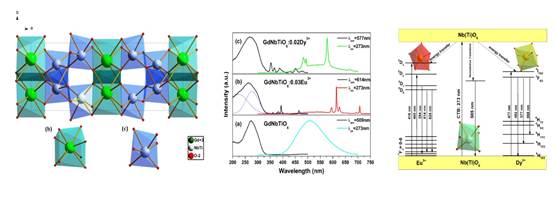In the past few decades, the research on functional materials of titanium niobate mainly focuses on the film and ceramic materials. In fact, the crystal structure of these compounds is relatively complex and their internal crystal field strength is much large, leading to be a kind of very good photoactive matrix material. Titanium niobates have many advantages such as simple synthesis process, high thermal stability, good chemical stability, and strong UV absorption ability and so on. In addition, niobate cation in the oxide generally has similar ionic radius and coordination situation to rare earth (RE) ions. Therefore, it is expected to develop new titanium niobate based phosphors by REs doping. A cooperative study group of Central South University of Forestry and Central South University studied the crystal structure, intrinsic luminescence properties, Eu3+ / Dy3+ activated luminescence properties and color-tuning mechanism of euxenite type GdNbTiO6. The related research results were published on May 18, 2016 in RSC Advance.
The vacuum ultraviolet fluorescence spectrum of GdNbTiO6 and GdNbTiO6: RE3+ (RE = Eu, Dy) were obtained by using Beijing Synchrotron Radiation Facility (BSRF). The team found that the Nb(Ti)O6 group in the GdNbTiO6 lattice emits a broad emission band with the strongest peak at 509 nm, which suggests the compound is a kind of self-activating matrix with wide absorption and wide emission. The Eu3+ / Dy3+ ions in the main lattice of the GdNbTiO6: RE3+ (RE = Eu, Dy) phosphors preferentially occupy the position of Gd3+. The emission peak of GdNbTiO6: Eu3+ phosphor is obtained from the 5D0→7F0-4 transition of Eu3+, which is a new type of fluorescent material with high brightness, high color uniformity, short fluorescence lifetime and color-tunable. While, GdNbTiO6: Dy3+ phosphor is a new type of yellow-green luminescent material. There is an effective radiation transfer between the host and RE3+ in these two type of phosphors. Combinating photoluminescence properties and fluorescence lifetime, the energy is transferred from the Nb(Ti)O6 group of the host to the Eu3+ and Dy3+ ions, and the energy transfer mechanism between the host and the rare earth ions is confirmed by dipole - dipole interaction.

Article: N. Liu, J.Y. Si*, G.M. Cai**, Y. Tao,Crystal structure, luminescent properties and energy transfer of Eu3+/Dy3+ doped GdNbTiO6 broad and excited phosphors. RSC Adv. 2016.6,50797-50807.


